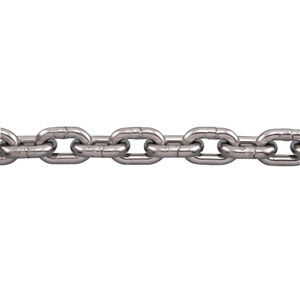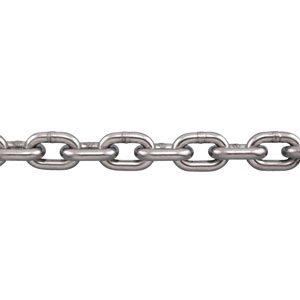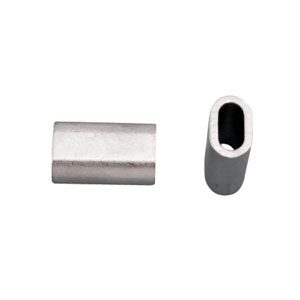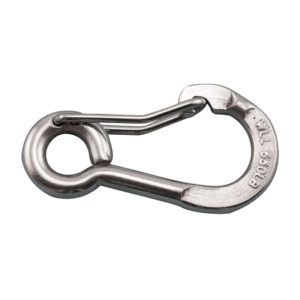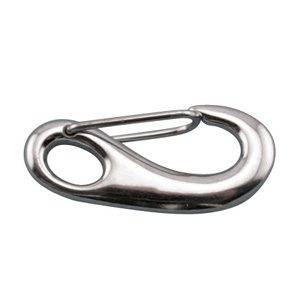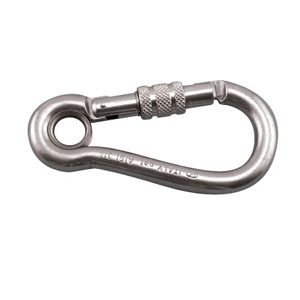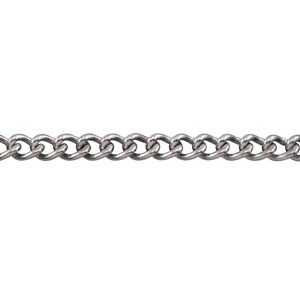Type 316L Stainless Steel BBB (bend before break) anchor chain is highly resistant to corrosion and stronger than galvanized chain, it has a higher working load than high test, proof coil chain of the same size. The shorter links of BBB anchor chain makes this chain ideal for many standard windlasses, verify with windlass manufacturer prior to purchase. The stainless steel finish gives a refined look to the anchor lead chain.
- Type 316L stainless steel
- Complies with all requirements of DIN 766
| Part # | Size (in) |
A (in) |
B (in) |
C (in) |
WLL (lb) |
BL (lb) |
Wt/Ft (lb) |
| S06010007 | 1/4 | 0.28 | 0.87 | 0.36 | 2,000 | 8,000 | 0.76 |
| S06010008 | 5/16 | 0.32 | 0.95 | 0.41 | 2,400 | 9,600 | 0.94 |
| S06010010 | 3/8 | 0.39 | 1.10 | 0.54 | 3,750 | 15,000 | 1.60 |
| S06010013 | 1/2 | 0.51 | 1.38 | 0.74 | 6,500 | 26,000 | 2.74 |

Important Information About Chain
- Never Exceed the Working Load Limit of ChainThe Working Load Limit (WLL) is the maximum load that should ever be applied to the chain, even when new and when the load is uniformly applied. Working Load Limit applies only to straight line pulls. When using multiple leg chain slings, the Working Load Limit of each leg will have to be reduced considerably depending on the angle of the sling legs. Consult industry recommendations for information, such as ASME B 30.9.When in doubt as to the Working Load Limit of the chain, refer to the periodic, permanently embossed grade marking on chain links. Proof Coil Chain is identified by P.C. or 30 or 3 or 28; High Test Chain by H.T. or 43 or 40 or 4; Transportation Chain by 70 or 7; Alloy Chain by 100 or 10 and 120 or 12.
- Use Only Alloy Chain for Overhead LiftingGrade 100 or 120 alloy chain is the only type of chain which can be used for overhead lifting. Use only grade 100 or 120 alloy fittings, respectively, for overhead lifting.
- Attachments must have at least the same Working Load Limit as the chain used
Hooks, links, shackles, etc. must be of suitable material and strength to provide adequate safety protection. - Keep out from under a raised loadDo not move load over people. Do not ride on load. Conduct all lifting operations in such a manner that if equipment were to fail or break, no personnel would be injured. This means KEEP OUT FROM UNDER A RAISED LOAD, do not operate loads over people and keep out of the line of force.
- Avoid Shock LoadsAvoid impacting, jerking or swinging of load. Working Load Limit will not apply in these circumstances because a shock load is generally significantly greater than the static load.
- Inspect Chain FrequentlyIt is important to keep a record on all chain slings. Depending on the use of the slings, they should be inspected regularly in accordance with national regulations (ASME B30.9). No product can keep operating at its rated capacity indefinitely. Closely examine each link and each attachment individually, taking care to expose inner link surfaces of chain and attachments. Visually inspect for wear, nicks, cracks, breaks, gouges, stretch, bends, weld splatter, discoloration from excessive heat, throat opening of hooks, corrosion, rust, etc. Chain and fittings must be withdrawn from service if any damage or deformation is noticed. Take chain out of service even if only one bad link is found. Eliminate twists and kinks in chain before using. Do not attempt to repair damaged or worn links in a chain. Do not attempt to weld, anneal, heat treat or hot galvanize alloy chain – its capacity will be completely destroyed. The medium link thickness must not be reduced by more than 10% of the nominal diameter on any part of the chain. The elongation of the chain should not exceed 5% at any point.
- Destroy Defective Chain
Destroy defective chain rather than discard the chain that is judged to be defective. Chain that is not destroyed might be used again by someone not aware of the hazard associated with that use. Destroying chain is best done by cutting it up into short pieces. - Chain Slings
Only grade 100 or 120 alloy chain can be used for overhead lifting. - Other standards and information may apply depending on specific use.
- Only Competent People
Lifting is dangerous work only competent persons are allowed to do. Please keep in mind all the hazards and risks covered in ASTM-A906, ISO3056, EN 818-6 and other relevant standards.

